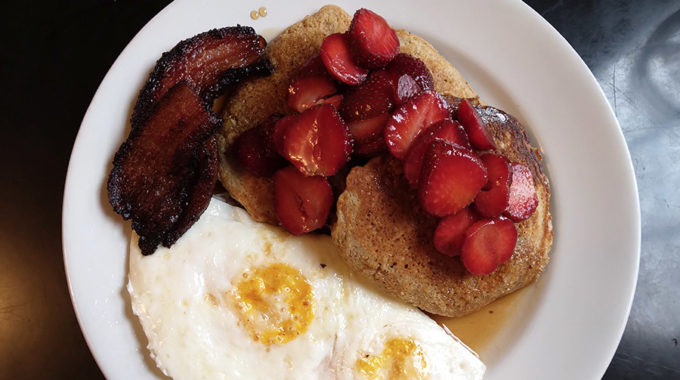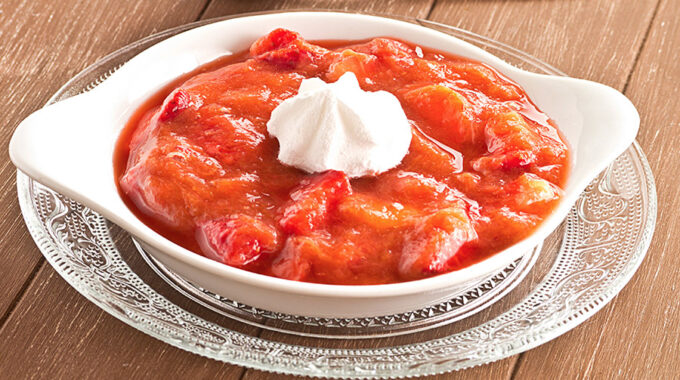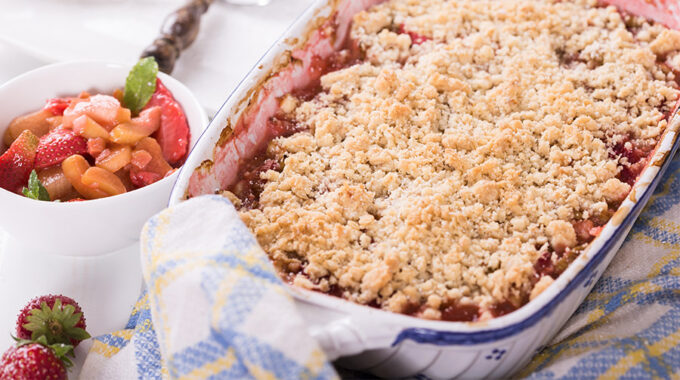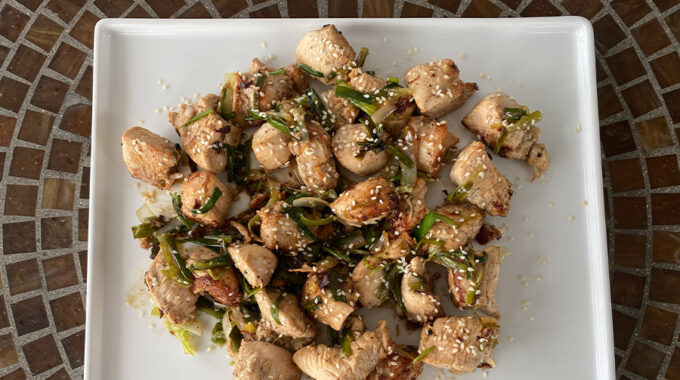Strawberry Rhubarb Compote by Norma Frye A compote or compôte (French for 'mixture') is a…

Recipe: Farmer’s Breakfast Oatmeal Pancakes with Strawberries
By Ellen Green
I assigned myself strawberries as our featured ingredient this month, and as I’ve chewed on what to write for the newsletter, I’ve run into a problem–I have way too much to say about strawberries. I have led a rather strawberry-flavored life. I grew up near a lot of U-pick farms, and since my siblings and I were homeschooled, we spent a lot of time outside picking and growing our own food. Strawberries, though, were kind of the most exciting–they were the first sweet thing we harvested. And, unlike so many other fruits and vegetables, the absolute best way to eat them is just as they are–straight from the bush to your mouth, ideally still a little warm from the sunshine.
My first job out of college, I lived and worked on a berry farm in the Berkshires. We grew every berry I’d ever heard of people eating–blueberries, strawberries, cranberries, currants–and a few I hadn’t–aronia, anyone? And every weekend, the old fix-it guy who lived on the farm would make oatmeal pancakes for all of us, and this is the recipe we’re going to make today. He started the pancakes at about 6 in the morning so they’d all be cooked by the time the rest of us got up. I’d yawn my way in around 7 and help him finish them up–I’d wash and cut up whatever berries we harvested the day before, cook some eggs, heat the syrup. But I never made the pancakes–that was his job. I did get him to tell me the recipe before I left, though, and scribbled it on a cryptic sticky note. I make them every couple weeks, and pile on whatever fruit looks best that week. I’ve made some tweaks over the years, but I still have that green sticky note.
I hung onto this recipe because these are really rib-sticking pancakes. Classic American diner-style pancakes, with white flour, aren’t hearty enough to go out and work in the field afterward. But these pancakes are essentially reformatted oatmeal, and they’ll keep you fed until lunch. I’ve experimented with other grains, too–basically anything works. I’ve used rye, steel-cut oats, farro, millet, amaranth, cornmeal, and probably a few other things I’ve forgotten. The photos show oats with amaranth. For grains that need a longer cooking time (steel cut oats, farro, etc.), I recommend simmering the grain in the soaking liquid for about 10 minutes before finishing the soak in the fridge.
A note on how to find and handle the best strawberries: they are delicate. A fully ripe strawberry will pretty much bruise if you touch it, so the fewer hands it passes through, the better it will be. If you can pick your own, I recommend doing it–it’s a fun day trip with kids. Otherwise, buy directly from a farmer, either at a farmstand or a market. For the very best fresh berries, pick or buy them when it hasn’t rained for a few days–they’ll be much more flavorful. If getting them from a farm isn’t an option, frozen is probably your best bet for flavor: frozen strawberries are trimmed and frozen very quickly after they’re picked.
Once you have fresh strawberries, keep them in the warmest part of your fridge and use them ASAP. Don’t wash them until right before you use them–they absorb water, and it will make them taste blander and rot faster. To trim them, cut or pull off just the stem, and trim any moldy or hard white parts with a sharp paring knife.
Farmer’s Breakfast Oatmeal Pancakes
vegetarian
for gluten free, sub gluten-free all purpose flour
for dairy free, sub plant-based milk
Time: about an hour active cooking time, overnight soak
Servings: 6
Equipment: a couple of lidded containers, a large mixing bowl, a mixing spoon, measuring cups, a large skillet (cast iron preferred, or use an electric skillet), spatula, paper towels, a cookie sheet
Ingredients:
- 2 quarts strawberries, fresh or frozen
- ¼ cup maple syrup or white sugar
- 2 cups rolled oats or other whole grains
- 2 cups milk or buttermilk
- ½ cup all-purpose flour
- 3 eggs
- 1 tsp baking powder
- 1 tsp baking soda
- ½ tsp cinnamon
- ½ tsp salt
- 1 tbsp maple syrup or white sugar
- 3 tbsp melted butter or oil
- a couple tablespoons of oil for the pan
The night before breakfast:
- Macerate* the strawberries: quarter or slice them, toss them with the ¼ cup syrup or sugar, and put them in a covered container in the fridge overnight. If you’re using frozen, toss them with the sweetener and put them in the fridge, then use a fork or potato masher to mash them slightly in the morning once they’ve thawed.
- Soak the oats: mix the oats and milk together in a container (a quart yogurt container is the right size), cover, and refrigerate overnight.
The morning of:
- Make coffee.
- Pour the soaked oats into a large mixing bowl. Add the flour, eggs, baking powder and soda, cinnamon, salt, maple syrup, and butter and stir just until combined. Don’t overmix!
- Set the oven to its lowest heat setting and put a cookie sheet in it.
- Cook the pancakes: heat a large pan over medium-low heat. Once drops of water sizzle and evaporate immediately, it’s ready. Add a few drops of oil and spread it around with a paper towel until you have a thin film in the pan. Pour in the batter–the photos show ¼ cup portions in a 12-inch pan, which works for me. Cook for 3-5 minutes on the first side without peeking, until the edges are glossy and set. Carefully flip and cook for about another minute, or until the bottoms are browned and the batter is dry in the middle (if you aren’t sure, poke a little hole in the top with a butter knife to check) . Transfer to the oven to keep warm, and then make more pancakes.
- Serve with a dollop of strawberries, a little extra maple syrup, and maybe even whipped cream–and fried eggs and bacon, if you like. When strawberries aren’t in season, have them with blueberries, peaches, or fried apples.
For waffles: separate the eggs. Add the yolks to the batter, and separately beat the whites to soft peaks. Once the batter is blended, gently fold in the egg whites. I like to add some finely chopped pecans to the batter if I’m making waffles.
*Macerating is a very useful technique when you’re making things with berries–it “cooks” them without heat, which would dull their flavor. The sugar draws liquid out of the berries, forming a syrupy sauce, and intensifying the flavor of the fruit. Macerated berries also keep longer than fresh, since the higher sugar concentration slows bacterial growth. You can do it with any kind of fruit–just cut them up or lightly mash them so the juice and sugar can mix together.
Bonus “recipe:” I was really happy with this salad. Butterhead lettuce, micro arugula, strawberries, chevre, toasted pecans, and maple-balsamic vinaigrette. Maple and strawberries get along really well, for some reason.



